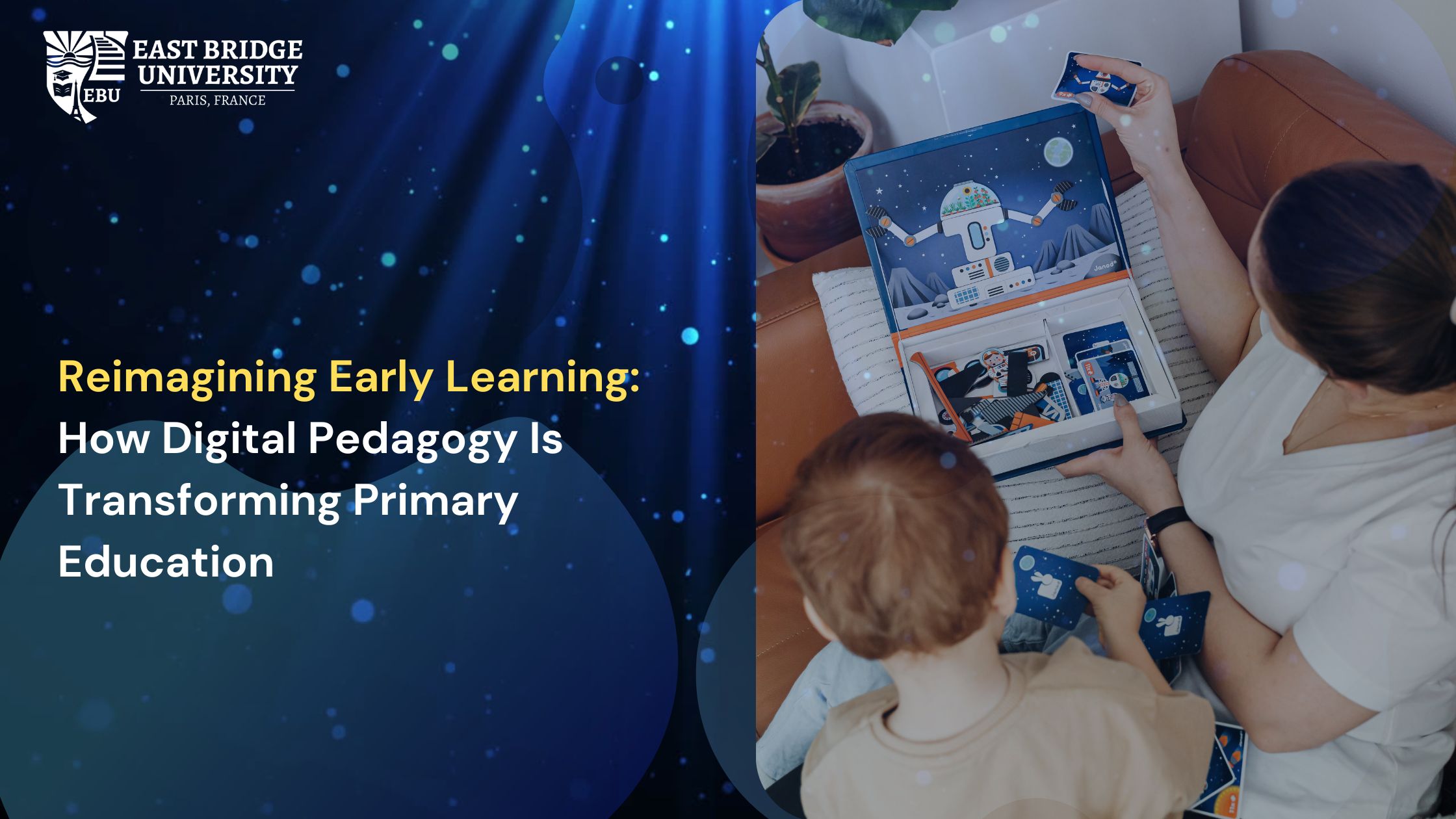In classrooms across the world, the chalkboard is no longer the sole source of education. Tablets sit next to textbooks, teachers use collaborating screens, and children learn through animated storytelling apps that make abstract ideas come alive. What was once a detached vision of futuristic learning is now a daily reality in schools that embrace digital pedagogy, the art of teaching with technology.
As early and primary education adapt to this transformation, one question takes center stage: how can technology boost, not replace, the warmth, curiosity, and human connection that define childhood learning?
From Digital Tools to Digital Thinking
For young learners, technology isn’t just about devices, it’s about mindset. A report by UNESCO (2023) shows that early exposure to interactive learning environments improves problem-solving, memory, and collaboration skills by up to 25% compared to traditional methods.
Digital pedagogy shifts focus from “teaching with tools” to teaching through interaction. Whether it’s storytelling apps that allow children to choose narrative endings or math games that reward creative reasoning, technology cultivates agency, the power for learners to make choices and see consequences.
For example, Finland’s early education programs use “digital play labs” where students use tablets to design simple stories or animations. The goal isn’t to produce coders, it’s to nurture thinkers who can connect ideas, visualize outcomes, and collaborate with peers.
The Role of Teachers: From Instructors to Facilitators
Technology doesn’t replace teachers, it amplifies them. In early education, emotional engagement and social cues remain central to effective learning. A 2024 OECD Education Report found that teacher-led digital activities yield 40% higher engagement than self-directed screen time.
The modern teacher acts as a facilitator of discovery, guiding children to navigate technology responsibly and purposefully. Instead of passively consuming content, learners are encouraged to create, to record stories, share digital artwork, or collaborate on mini-projects using safe online platforms.
Teachers are also using technology to better understand their students. AI-assisted assessment tools track not only test scores but behavioral patterns, like participation, curiosity, or hesitation, helping educators adapt their methods for each learner’s needs.
This data-driven personalization makes inclusion more attainable than ever before. Students who struggle with attention, sensory processing, or language can now access assistive technologies, from text-to-speech tools to tactile learning apps, allowing them to learn at their own pace without stigma.
Digital Classrooms That Build Real-World Skills
In early and primary years, technology can seem like play—but the learning outcomes are profound.
A Brookings Institution study (2023) revealed that children exposed to structured digital activities demonstrate 15% greater cognitive flexibility and higher retention compared to peers in traditional-only settings.
For instance:
Interactive whiteboards help children visualize complex topics—like the water cycle or number sequences, through animation and simulation.
Coding for kids’ platforms like Scratch Junior or Kodable teach logic, sequencing, and persistence through playful design.
Augmented reality (AR) lessons bring geography, art, or science to life students can “step inside” a rainforest or “walk through” ancient pyramids.
These experiences make abstract knowledge tangible and memorable. They also mirror how information is encountered in the real world, digitally layered, interactive, and problem-driven.
The Inclusion Imperious: Technology for Every Learner
Equity in access remains one of education’s most pressing challenges. While digital pedagogy offers immense benefits, it also risks widening the gap between those who have access and those who don’t.
According to UNICEF (2024), one in three children worldwide lacks adequate access to digital learning tools. Bridging this gap requires collaborative action, governments, NGOs, and private institutions investing not just in hardware, but in teacher training and community infrastructure.
Inclusivity also extends to learning diversity. For children with disabilities or different learning styles, digital pedagogy offers adaptive content that can read aloud, magnify text, or provide sign language interpretation.
Technology, when used deliberately, levels the learning field rather than dividing it.
The Power of Play and Emotional Connection
Early learning thrives on joy, exploration, and connection. The best digital pedagogy recognizes this emotional foundation. Gamified learning models, such as ClassDojo or Seesaw, allow children to earn badges for effort, collaboration, and creativity rather than only for grades.
These systems foster intrinsic motivation, a sense of achievement linked to progress and participation, not perfection.
Moreover, digital storytelling platforms enable children to express their voices. A shy student who hesitates to speak in class might create a narrated animation about their day. Technology thus becomes a medium for self-expression, helping teachers understand their students beyond traditional assessments.
Research from Harvard Graduate School of Education (2023) supports this: children who engage in “digital storytelling projects” show 20% higher empathy scores and stronger communication skills after six months of use.
Supporting Teachers Through Technology
While students benefit from digital tools, educators need equal support. Effective digital pedagogy begins with teacher empowerment, continuous training, resource access, and community learning.
Professional learning communities (PLCs) have evolved into exciting online ecosystems where teachers share lesson plans, discuss tech tools, and troubleshoot challenges together. According to Education International (2024), schools that provide consistent digital training see a 35% increase in classroom tech integration and greater student engagement.
Technology also streamlines administrative tasks, automating grading, attendance, and communication, giving teachers more time to focus on what matters most: teaching and connecting with students.
The Ethical Side of Digital Learning
As screens become central to education, conversations around digital well-being and ethics are crucial. Educators and parents must guide children in developing healthy digital habits, from screen-time balance to online safety and empathy in digital communication.
Including digital citizenship lessons into the curriculum teaches children early on about respect, privacy, and responsibility online. These life skills prepare them not just to use technology, but to thrive with it.
Looking Ahead: The Future of Early Education
The next edge of early education will likely blend AI, augmented reality, and human-centered pedagogy. Imagine classrooms where each child’s learning dashboard adapts in real-time, suggesting personalized stories or exercises. Or playgrounds that merge physical play with digital storytelling, turning curiosity into an immersive journey of discovery.
The goal isn’t to digitize childhood but to enhance its natural wonder through creativity, collaboration, and inclusion. As educators and policymakers, our task is to ensure technology remains a bridge, not a barrier, to equity, empathy, and excellence.
To End With
Technology and digital pedagogy are redefining what early learning can be, interactive, inclusive, and deeply human. By combining data-driven visions with emotional intelligence, teachers can create classrooms that inspire curiosity while building the cognitive and social foundations for lifelong learning.
For aspiring educators looking to shape the next generation, programs like the B.Ed. in Pre and Primary Education and the B.Ed. in Primary Education offer the perfect pathway to master these evolving teaching methodologies, empowering teachers to guide, nurture, and innovate in a world where every click can spark inquisitiveness.
Written By : Christina B




